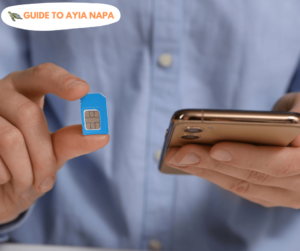Ah, Ayia Napa—where the sun kisses the sea, and the weather practically begs you to stay outdoors all year round!
If you’re wondering what the weather and climate in Ayia Napa are like, let’s get straight to the point:
- Summers are hot, dry, and long, with temperatures soaring above 30°C (86°F).
- Winters are mild and short, rarely dropping below 10°C (50°F).
- Spring and autumn? A perfect mix of warmth and breeze, ideal for sightseeing and adventure.
- The sea stays inviting year-round, making it a paradise for beach lovers and water sports enthusiasts.
Now that you have the short answer, let’s dive into the details so you can plan your trip like a pro!

Ayia Napa’s Weather Overview
Ayia Napa enjoys a Mediterranean climate, meaning long, hot summers and short, mild winters.
With around 300 sunny days per year, rain is a rare guest here, and even in winter, it doesn’t overstay its welcome.
The hottest months are July and August, when temperatures can soar past 40°C (104°F), while the coldest months (January and February) still manage to stay around a comfortable 15–20°C (59–68°F).
The sea remains warm enough for swimming nearly all year, with water temperatures ranging from 16°C (61°F) in winter to 28°C (82°F) in summer.
If you’re still undecided about when to visit, let’s break it down month by month!
Sun, Sand, and a Hint of Breeze
Ayia Napa’s climate is Mediterranean, meaning hot, sunny summers and mild, rainy winters.
Expect around 300 days of sunshine a year, so forget about packing an umbrella (unless you want to use it as a sunshade!).
The peak summer months (June–September) turn Ayia Napa into a sizzling paradise. With temperatures hovering between 30°C and 40°C (86°F–104°F), sunblock becomes your best friend.
Thankfully, the sea breeze makes the heat more bearable, and the Mediterranean waters stay at a delightful 26°C (79°F) or more—perfect for swimming, snorkeling, and jet skiing.
Winter in Ayia Napa: A Mellow Retreat
While much of Europe shivers, Ayia Napa enjoys a relatively mild winter (December–February).
Daytime temperatures range from 15°C to 20°C (59°F–68°F), but evenings can feel chilly, dipping to around 8°C–12°C (46°F–54°F).
It’s also the rainiest season, though showers are usually brief and scattered.
This is when the island’s landscape turns lush and green—a rare sight for those only familiar with its golden beaches.
Spring & Autumn: The Sweet Spot
Spring (March–May) and autumn (October–November) are arguably the best times to visit Ayia Napa.
The weather remains pleasantly warm, around 20°C–28°C (68°F–82°F), and the crowds thin out.
These months are ideal for exploring nature trails, boat trips, and historical sites, without the summer’s scorching heat or the winter’s occasional rain.
Sea Temperature: Always Inviting
Good news for beach bums—the sea in Ayia Napa never really gets too cold!
Even in winter, the water temperature rarely drops below 16°C (61°F).
By May, it starts climbing back to 22°C (72°F) and peaks at 28°C (82°F) in August.
| Season | Temperature Range (°C) | Weather Features | Best For |
|---|---|---|---|
| Summer (June–September) | 30–40°C | Hot, dry, sunny | Beach lovers, nightlife, water sports |
| Winter (December–February) | 15–20°C (day) / 8–12°C (night) | Mild, occasional rain | Hiking, sightseeing, quiet retreats |
| Spring (March–May) | 20–28°C | Pleasantly warm, minimal rain | Exploring, boat trips, nature walks |
| Autumn (October–November) | 20–28°C | Warm, less crowded | Relaxation, cultural experiences |
| Sea Temperature | 16–28°C | Swimmable year-round | Snorkeling, diving, swimming |
Ayia Napa’s Weather – Month by Month
January: The Coolest Month (But Still Not Cold!)
- Daytime Temperature: 15–18°C (59–64°F)
- Nighttime Temperature: 8–12°C (46–54°F)
- Sea Temperature: 16°C (61°F)
- Rain: Occasional showers
- Vibe: Peaceful, quiet, and great for exploring
January is Ayia Napa’s coldest month, but let’s be honest—it’s still warmer than most European spring days!
It’s an excellent time for hiking and sightseeing without sweating buckets.
The sea is chilly but swimmable, and you’ll have the beaches almost to yourself.
February: The Last Breath of Winter
- Daytime Temperature: 16–19°C (61–66°F)
- Nighttime Temperature: 8–12°C (46–54°F)
- Sea Temperature: 16°C (61°F)
- Rain: Some rain, but not much
- Vibe: Quiet, off-season deals, great for nature walks
February feels like a milder January—cool, but not freezing.
Rain showers happen, but the sun usually wins.
If you love peaceful getaways, this is a great time to visit.
March: Spring Awakens
- Daytime Temperature: 18–22°C (64–72°F)
- Nighttime Temperature: 10–14°C (50–57°F)
- Sea Temperature: 17°C (63°F)
- Rain: Less frequent
- Vibe: Nature starts blooming, perfect for exploration
March marks the start of spring, with warmer temperatures and longer daylight hours.
It’s the ideal month for hiking, cycling, and boat trips before the summer crowds arrive.
April: The Goldilocks Month
- Daytime Temperature: 20–25°C (68–77°F)
- Nighttime Temperature: 12–16°C (54–61°F)
- Sea Temperature: 18°C (64°F)
- Rain: Rare
- Vibe: Beautiful weather, fewer crowds, perfect for everything
April is one of the best months to visit Ayia Napa—warm but not too hot, the sea is warming up, and everything is still lush from winter rains.
May: Beach Season Begins
- Daytime Temperature: 24–28°C (75–82°F)
- Nighttime Temperature: 16–20°C (61–68°F)
- Sea Temperature: 22°C (72°F)
- Rain: Almost none
- Vibe: Perfect for sunbathing and swimming
May officially kicks off beach season!
The sea is warm enough for long swims, and the summer buzz builds.
June: The Start of the Heatwave
- Daytime Temperature: 28–32°C (82–90°F)
- Nighttime Temperature: 20–24°C (68–75°F)
- Sea Temperature: 24°C (75°F)
- Rain: Zero
- Vibe: Summer vibes, perfect for nightlife and beach clubs
June brings hotter days and longer nights, making it ideal for parties, water sports, and tanning.
July & August: Peak Summer
- Daytime Temperature: 32–40°C (90–104°F)
- Nighttime Temperature: 24–28°C (75–82°F)
- Sea Temperature: 26–28°C (79–82°F)
- Rain: None
- Vibe: Hot, crowded, and full of energy
This is prime time for Ayia Napa—think scorching sun, packed beaches, and non-stop parties.
If you love the heat and nightlife, this is your moment.
September: Summer Without the Madness
- Daytime Temperature: 28–34°C (82–93°F)
- Nighttime Temperature: 22–26°C (72–79°F)
- Sea Temperature: 26°C (79°F)
- Rain: Rare
- Vibe: Warm, fun, but calmer
September is arguably the best month—summer weather with fewer crowds.
October: Warm & Wonderful
- Daytime Temperature: 24–28°C (75–82°F)
- Nighttime Temperature: 18–22°C (64–72°F)
- Sea Temperature: 24°C (75°F)
- Rain: Some showers late in the month
- Vibe: Relaxed, great for sightseeing and swimming
October still feels like summer, with milder nights and more breathing space.
November: The Gentle Cool-Down
- Daytime Temperature: 20–24°C (68–75°F)
- Nighttime Temperature: 14–18°C (57–64°F)
- Sea Temperature: 22°C (72°F)
- Rain: A few showers
- Vibe: Quiet, but still beach-worthy
November feels like early spring, making it an excellent time for relaxed getaways.
December: A Winter Escape
- Daytime Temperature: 16–20°C (61–68°F)
- Nighttime Temperature: 10–14°C (50–57°F)
- Sea Temperature: 18°C (64°F)
- Rain: More frequent
- Vibe: Tranquil, ideal for exploring nature and history
December in Ayia Napa is a peaceful winter escape with mild temperatures and a mix of sunny and rainy days.
How to dress in Ayia Napa?
Packing for Ayia Napa? Whether you’re coming for a sun-soaked summer adventure or a mild winter escape, knowing what to wear will keep you comfortable and stylish.
Here’s a month-by-month breakdown of what to pack!
January – Cool and Casual
What to Wear:
- Light jacket or sweater for the day
- Warm layers (hoodie, fleece) for the evening
- Long pants and closed shoes
- An umbrella (just in case of rain)
Why?
January is the coldest month, but still mild. Layers are essential as mornings and evenings are cooler.
February – Similar to January, But a Little Warmer
What to Wear:
- Light sweater or jacket
- Long-sleeve tops and jeans
- Sneakers or comfortable walking shoes
- Raincoat or umbrella for occasional showers
Why?
February still has cool mornings and evenings, but daytime is getting warmer. Light layers work best!
March – Spring Awakens
What to Wear:
- Light jacket or hoodie for evenings
- T-shirts and jeans/long pants
- Sneakers for exploring
- Sunglasses (spring sun starts to shine)
Why?
March is warmer but still unpredictable. You’ll want a mix of warm and light clothing.
April – The Start of Warm Days
What to Wear:
- T-shirts and shorts for the day
- Light sweater for evenings
- Comfortable sandals or sneakers
- Swimwear (if you want an early dip in the sea!)
Why?
April is pleasant and sunny, but evenings can still be cool, so bring a light jacket.
May – Beach Season Begins
What to Wear:
- T-shirts, shorts, and summer dresses
- Swimwear and beach cover-ups
- Flip-flops or sandals
- Sunglasses, hat, and sunscreen
Why?
May is warm but not scorching, making it perfect for summer outfits.
June – The Heat Rises
What to Wear:
- Light summer clothing (tank tops, shorts, dresses)
- Swimwear (you’ll be at the beach a lot!)
- Sunglasses and a wide-brimmed hat
- Sandals and flip-flops
Why?
June is hot and dry, so light, breathable clothing is necessary.
July & August – Peak Heat & Sun
What to Wear:
- The lightest clothes possible (cotton, linen, or loose fabrics)
- Swimwear and cover-ups
- Strong sunscreen, sunglasses, and a hat
- Flip-flops or light sandals
Why?
These are the hottest months, so avoid dark, heavy clothes. Stay cool and hydrated!
September – Still Summer, But More Comfortable
What to Wear:
- Summer clothes (T-shirts, shorts, dresses)
- Swimwear for the beach
- Light jacket for late nights
- Comfortable sandals
Why?
September is still hot, but cooler than peak summer. Perfect weather for beachwear and casual outfits.
October – The Perfect Balance
What to Wear:
- Light summer clothes for daytime
- A light jacket or cardigan for evenings
- Swimwear (sea is still warm!)
- Sneakers for sightseeing
Why?
October offers warm days and slightly cooler nights, so bring a mix of light and warm clothes.
November – The Cool-Down Begins
What to Wear:
- Light sweater and long pants
- T-shirts for the daytime
- Sneakers or comfortable shoes
- Swimwear (if you don’t mind a calmer sea)
Why?
November still feels like early autumn, but you’ll need layers for the evening.
December – A Mild Mediterranean Winter
What to Wear:
- Light jacket or coat
- Sweaters and jeans
- Closed shoes or sneakers
- Umbrella for occasional rain
Why?
December is mild, but evenings are cool, so bring warm layers for comfort.
Final Packing Tips for Ayia Napa
✅ Always pack sunscreen, even in winter! The sun is strong year-round.
✅ Bring a hat and sunglasses—you’ll use them every month.
✅ Swimwear is essential from April to November.
✅ Even in winter, light layers work best—no need for heavy coats.
✅ For nightlife, casual summer outfits work, but some clubs may have a dress code.
Now you’re ready to dress smart for every season in Ayia Napa! 🌞
| Month | Daytime Outfit | Evening Outfit | Footwear | Extras |
|---|---|---|---|---|
| January | Light jacket, long pants | Warm layers (hoodie, fleece) | Closed shoes | Umbrella for occasional rain |
| February | Light sweater, jeans | Jacket for cooler nights | Sneakers or walking shoes | Raincoat for brief showers |
| March | T-shirts, long pants | Light jacket or hoodie | Sneakers | Sunglasses, light layers |
| April | Shorts, T-shirts | Light sweater for evenings | Sandals or sneakers | Swimwear (optional) |
| May | Summer clothes, shorts, dresses | Light jacket for late nights | Flip-flops, sandals | Sunscreen, hat, sunglasses |
| June | Tank tops, light shorts | Very light layers | Sandals or flip-flops | Swimwear, sunscreen, hat |
| July | Breathable summer outfits | Minimal layers, still warm | Flip-flops, sandals | Sunblock, sunglasses, hat |
| August | Loose, lightweight clothing | Still warm at night | Flip-flops or sandals | Stay hydrated, use SPF |
| September | Summer clothes, light fabrics | Light sweater for cooler nights | Sandals, sneakers | Swimwear, sunglasses |
| October | T-shirts, shorts | Light jacket or cardigan | Sneakers, sandals | Sun protection, comfortable shoes |
| November | Light sweater, long pants | Jacket for the evening | Sneakers, walking shoes | Umbrella for occasional rain |
| December | Long-sleeve shirts, jeans | Light coat or jacket | Closed shoes | Umbrella, warm layers |
Conclusion
Whether you’re after blazing sun for a tan, mild temperatures for hiking, or an incredible winter escape, Ayia Napa’s weather has something for every traveler.
With year-round sunshine, warm seas, and only a handful of rainy days, it’s the kind of place where bad weather is almost a myth.
So, whatever season you choose, rest assured—Mother Nature is on your side in Ayia Napa!
What is the best month to visit Ayia Napa?
May, June, September, and October offer warm weather, fewer crowds, and pleasant sea temperatures.
Does it ever rain in Ayia Napa?
Yes, but mostly in winter (December–February). The rest of the year is mostly dry and sunny.
How hot does Ayia Napa get in summer?
Temperatures can reach 40°C (104°F) in July and August, but the sea breeze helps.
Can you swim in Ayia Napa in winter?
Yes! The sea stays around 16°C (61°F) at its coldest, which is still swimmable for many.
What’s the hottest month in Ayia Napa?
July and August, with temperatures reaching 40°C (104°F).
What’s the rainiest month?
January sees the most rain, but it’s still mostly sunny.








